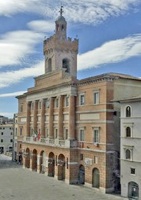
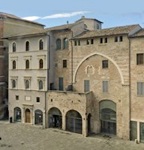
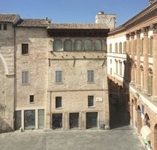
Palazzo Comunale Palazzo Orfini and Palazzetto del Podestà
Ex-Palazzo Comunale
Free Commune
As Bernardino Lattanzi (referenced below, at pp. 247 and 253) pointed out, the earliest evidence of comunale government in Foligno dates to 1177, when the Emperor Frederick I recognised the “consulibus fulginatibus dilectis fidelibus” (beloved and faithful consuls of Foligno). Lattanzi also identified (at p. 257):
-
✴the first known Podestà, Ranuccio di Viscarano, who served in 1198; and
-
✴the first known Capitano del Popolo, Ruggiere di Pizzi, whom the Emperor Frederick II appointed in 1250.
From 1305, political power lay with the priors (three, then four, then six), although the Podestà and the Capitano del Popolo retained judicial roles. This arrangement was maintained under the Trinci lords (1305-1439) and subsequently under the papacy, although increasingly as a matter of form rather than substance.
The administrative heart of Foligno was in ‘platea Communis’ (now Piazza della Repubblica) for almost all of this period. Bishop Anselmo degli Atti built the left transept of the Duomo of Foligno in 1201, which had its facade on the opposite side of the piazza. Its portal contains reliefs of Innocent III and an emperor, presumably Otto of Brunswick, whom Innocent had just recognised as Emperor-elect, in recognition of the newly-won papal supremacy in Italy.
However, when Frederick II became Emperor in 1220, the Ghibelline faction in Foligno came to the fore. In February 1240, the city welcomed the now-excommunicated Frederick II, who chose this as the location for a ‘generale parliamentum’, which was attended by representatives of the neighbouring Ghibelline cities, who were now formally in alliance against the Guelphs. According to Mario Sensi (referenced below, at p. 405):
-
“... in order to make Foligno the centre of a Ghibelline federation, adequate defences ... were needed. This led to the decision, perhaps taken at the parliament, to construct ex novo the circuit of walls and the ‘palatium imperiale’” (my translation).
As described below, this palace apparently became the administrative heart of Foligno until its defeat at the hands of Guelph Perugia in 1253. After this ‘Ghibelline’ interlude, the civic administration returned to what was now ‘platea veteri Communis’.
Palazzo Imperiale (1240 ?)
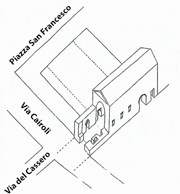
Reconstruction of the so-called Palazzo Imperiale
From Vladimiro Cruciani, “Foligno: la Pietra Racconta”, (1990) Foligno
Federico II appointed Rufino da Lodi as his legate to Foligno and charged him with the construction project that included the new city walls and (apparently) the imperial palace. What we know of the subsequent history of this palace has to be deduced from documentation that relates to the period after the defeat of 1253:
-
✴In 1255, Pope Alexander IV authorised the Friars Minor at San Matteo (a small church that was later incorporated into the church of San Francesco) to take possession of the adjacent ‘palatium curiae ... quod imperiale vocatur’ (i.e. the curial palace ... called imperial), which formed the nucleus of their new convent.
-
✴In 1256, a noblewoman, Margherita di Filippo Ofreduti, endowed the new foundation in her will, which was drawn up ‘in palatio quondam communis Fulginei ubi nunc est ecclesis fratrum minori’ (in the palace that once belonged to the Commune of Foligno, where now is the church of the Friars Minor).
Thus, the ‘palatium imperiale’ had also housed the administration of the Commune until 1253. The city administration then moved back to what became the ‘platea veteri Communis’, while the ‘palatium imperiale’ briefly became the ‘palatium curiae’, before its incorporation into the new Franciscan convent.
Public Palaces in Piazza della Repubblica
Palazzo Comunale (1546-1642)
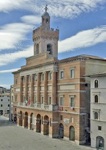
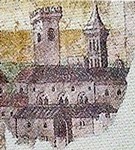
Detail of fresco (1467)
by Pierantonio Mezzastris
Madonna della Fiamenga
The exterior walls of the original Palazzo Comunale (13th century) and the base of its campanile can be seen from Via Colomba Antonietti, the street under the open archway in the present façade. The appearance of this part of the complex in ca. 1467 is captured in the detail of fresco by Pierantonio Mezzastris (illustrated above). The original campanile still survives at the heart of the present Palazzo Comunale: it has retained its original appearance, albeit that it now has a lantern adorned with the lily of Foligno. This campanile was at the geometric centre of the city and was probably used as the main point of reference when the line of the "new" city walls was planned in the 14th century.
The palace was radically restructured in 1546-65 by an architect named as Master Julio. The well that survives in the atrium of the present structure is dated 1567. The palace was restored again in 1629-42
The palace took on its present appearance after the extensive restoration carried out by Antonio Molari in 1835-8, after the earthquake of 1832. His work, which concentrated on improving the symmetry of the palace, and included the design of the neoclassical facade. The clock was installed in 1909. The north wing of the palace had to be rebuilt after the damage inflicted in Second World War.
In its present form, the central part of the palace links two side wings.
-
✴The central part of the facade has a ground floor loggia of five arches.
-
✴Six Ionic columns on the second and third storeys support a travertine parapet that carries the inscription SPQF (Senatus Populusque Fulginei).
Frescoes of Sala Consiliare (1884-7)
The main council chamber dominates the piano nobile of the palace. The Commune commissioned its frescoes from Mariano Piervittori in 1884. They depict:
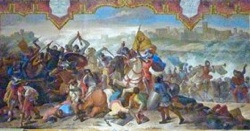
-
✴Count Robbacastelli da Foligno, the general of the Milanese army, defeating the Emperor Frederick I at Ponte di Cassano on the River Adda in 1158;
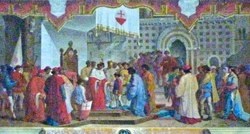
-
✴the arrival of the young Emperor Frederick II in Foligno in 1198;
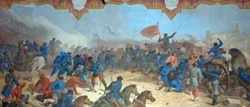
-
✴the death in 1849 of Colomba Antonietti (who had moved to Foligno as a young boy) in the defence of the Roman Republic from the French; and
-
✴personifications, including those of Knowledge, Strength, Prudence and Justice, in the vaults.
Frescoes of Sala delle Armi (1760)
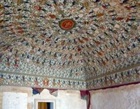
Palazzo Orfini (1515)
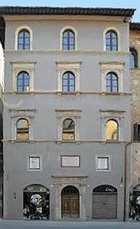
-
✴Mario Sensi (referenced below, 1986, at pp. 388-9, note 15) quoted the document of 1497 that notarised the purchase by Emiliano Orfini of an adjoining property in “platea veteri”, between Via Pertichetti and the residence of the Podetsà.
-
✴The inscription over the portal of what is now Palazzo Orfini reads: PETRUS ORPHINUS DI ORPHINUS MDXV. This suggests that the present facade was built by Emiliano’s heir in 1515.
The premises were used for both residential and commercial purposes. Perhaps that is why the inscription over the lovely portal in Via Pertichetti reads “LABORANDUM UT QUIESCAS” (work in order to rest).
The Orfini family famously financed the activities of the exiled German printer Johann Numeister, who had left Germany after the sack of Mainz in 1462, and was in Foligno by 1463. As a result of this collaboration, Foligno became an early centre of printing using moveable type in Italy. [One of the printing presses used at this time is now in the sacristy of the Oratorio della Nunziatella.] Emiliano Orfini, who had worked as a goldsmith and a minter of coins in the Vatican, collaborated with Johann Numeister as an engraver as well as a financier:
-
✴An edition (1470) of Leonardo Bruni’s “De bello Italico adversus Gothos” records on its title page that:
-
"Hunc libellum Emilianus de Orfinis Fulginas et Johannes Numeister Theutonicus feliciter impresserunt”.
-
✴An edition (ca. 1471) of Cicero’s “Epistolae ad familiares” records on its title page that:
-
"Emilianus auctor fulginas et fratres una ingenio prestante viri... Fulginei acta vides et laribus Emiliani”.
However, the title page of Numeister’s edition (1472) of the ‘Divine Comedy’ does not refer to the Orfini family, although it does credit Numeister’s collaborator, Evangelista di Angelini da Trevi. Apparently, Numeister was imprisoned in the following year for failing to honour his debts. It is thus unclear whether his arrangement with the Orfini was still extant and, in particular, whether Numeister’s edition of the ‘Divine Comedy’ was actually was printed under their auspices.
So-called Palazzetto del Podestà (late 12th century)
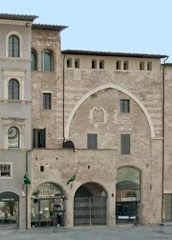

Extension (1262-5) Original palace and tower (late 12th century)
The original palace and adjacent (now truncated) tower on the corner with Via Gramsci was probably the first palace of the Commune of Foligno. Its construction probably prompted the decision to build the left transept of the Duomo: its magnificent facade opposite the palace was completed in 1201. [The well in front of the palace, which was excavated in 1980, can be seen under the present paving of the piazza]
This palace was probably vacated in ca. 1220, when the Ghibelline administration moved to the so-called Palazzo Imperiale. After the Perugian victory in 1253, the latter palace passed to the friars of San Francesco, and the new administration probably returned to this original site.
Bonaventura di Benvenuto (died 1346) recorded that, in 1262, “fuit inceptum palatium communis” and that the project was completed in 1265. The full scope of this work is unknown, but the huge arch on the facade of the building between the original palace an Palazzo Orfini is usually dated to this period.
This complex probably became known as Palazzo dei Priori after 1305:
-
✴A document of 1446 records that the priors had commissioned “pluras laborerias et picturas” (many works and pictures) from Andrea di Cagno, which included work at Palazzo dei Priori.
-
✴In 1479, the Priors commissioned frescoes (now lost) of the Annunciation and the patron saints of Foligno from Ugolino di Gisberto for the “new lower loggia” of this palace. This may have been the ground-floor loggia, of which two arches still survive.
Stefano Felicetti (referenced below) catalogued these documents as (respectively): entry 21, p. 34; and entry 165, p. 80).
Later Decoration of the Original Palace
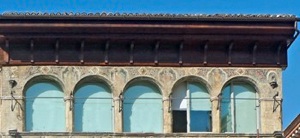
In 1404-17 Ugolino Trinci also acquired houses on the other side of what is now Via Gramsci (to the right), and these later formed the nucleus of Palazzo Trinci. The Trinci family built the loggia on the top floor of the original palace This loggia was documented in 1423 and again, as the “logia nova”, in 1429. This has led some scholars to suggest that it was built in ca. 1420; however, the discovery of its original frescoes in 1986 (see below) has led to the conclusion that it was probably built at the same time as Palazzo Trinci (i.e. before 1411).
The decoration of the loggia seem to have formed part of the original programme devised for Palazzo Trinci:
-
✴Seven Roman heads representing the seven ages of man, which were originally on pediments below the windows, are now in the Trinci Collection in Palazzo Trinci. This theme recurs in the frescoes of Palazzo Trinci.
-
✴Traces of the original frescoes survive:
-

-


-

-

-
•The (nearly) monochrome frescoes in the frieze along the top of the the interior walls, which were discovered in 1986, are very similar to frescoes (ca. 1407) that Ugolino III Trinci commissioned for the corridor that links Palazzo Trinci to the Duomo. Francesco Federico Mancini (referenced below) deduced that one fresco probably illustrates the mythical founding of Foligno after the burning of Troy, while the other scenes demonstrate the virtues and legitimacy of the Trinci family.
-

-
•The frescoes on the exterior facade, above the windows of the loggia, which represent the Cardinal Virtues, reinforce this theme.
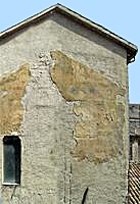

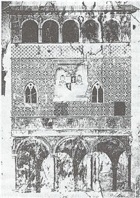
-
✴The two windows in the middle register were originally bifore.
-
✴There was originally a loggia of three arches in front of the present facade, at ground-level. According to Lattanzi, surviving documents record that the podestà, Polidoro Tiberti da Cesena, built it in 1484 and that it was demolished in 1832, when the facade of Palazzo Trinci was rebuilt.
-
✴The arms of Pope Adrian VI (1522-3) and Cardinal Franceso Armellini were inserted between the two windows in the middle register, presumably during the brief reign of this pontiff.
Read more:
F. Mancini, “La Loggia delle Virtù: Allegoria di un Governo Illuminato”,
in G. Benazzi and F. Mancini (Eds), “Il Palazzo Trinci di Foligno”, (2001) Perugia, pp 303-336
S. Felicetti, “I Pittori di Foligno nei Documenti d’ Archivio (1439-1502): Verifiche e Nuove Ricerche”,
in B. Toscano (Ed), “Pittura a Foligno (1439-1502)”, (2000) Foligno
M. Sensi, “Un Palatium Imperiale a Foligno e un Castrum Imperiale a Spello in Età Federiciana”, Bollettino Storico della Città di Foligno", 20-1 (1996-7) 393-424 B. Lattanzi, “Storia di Foligno: Dalle Origini al 1305” (1994) Rome
M. Sensi and B. Sperandio, “La Loggia dei Trinci sul Palazzo già Municipale e Pretorio, il Cosiddetto Palazzetto del Podestà”, Bollettino Storico della Città di Foligno, 10 (1986) pp. 385-412
Return to the page on Monuments of Foligno.
Return to Walk II.



